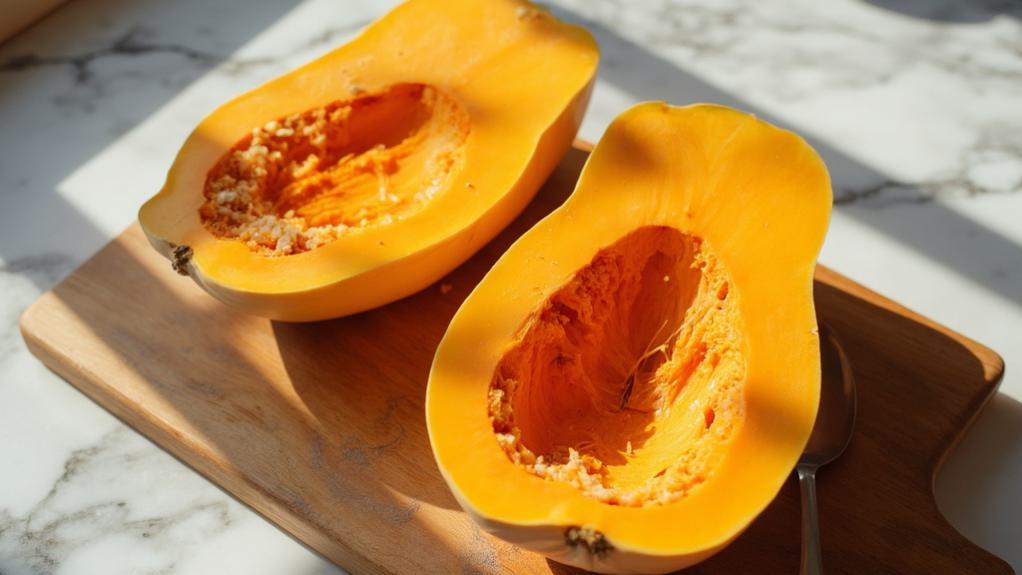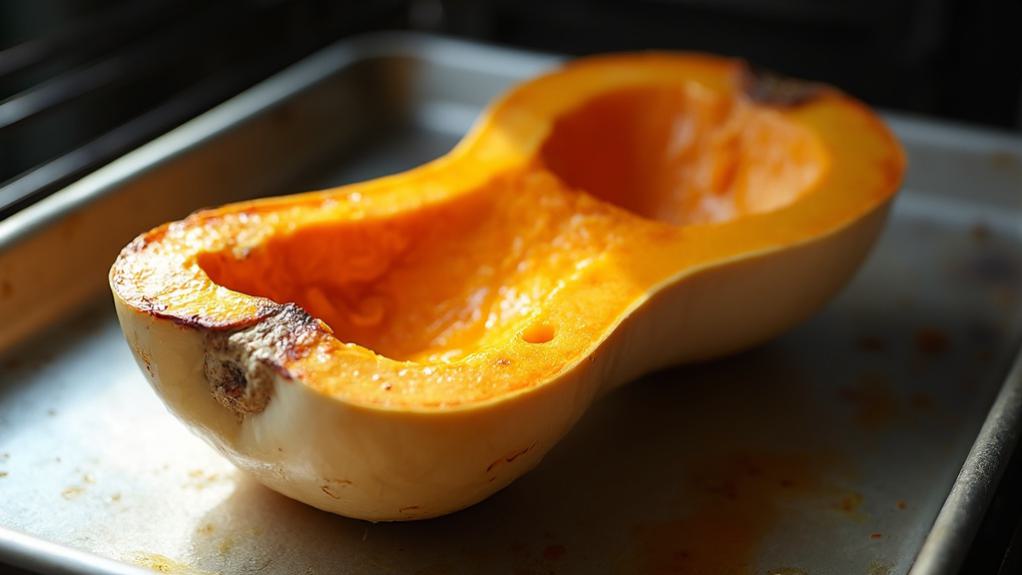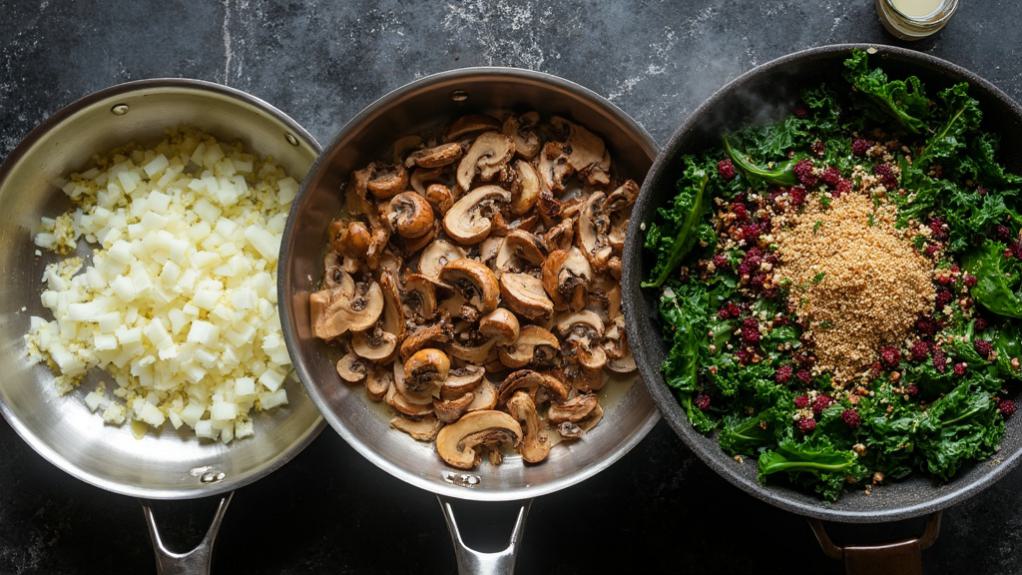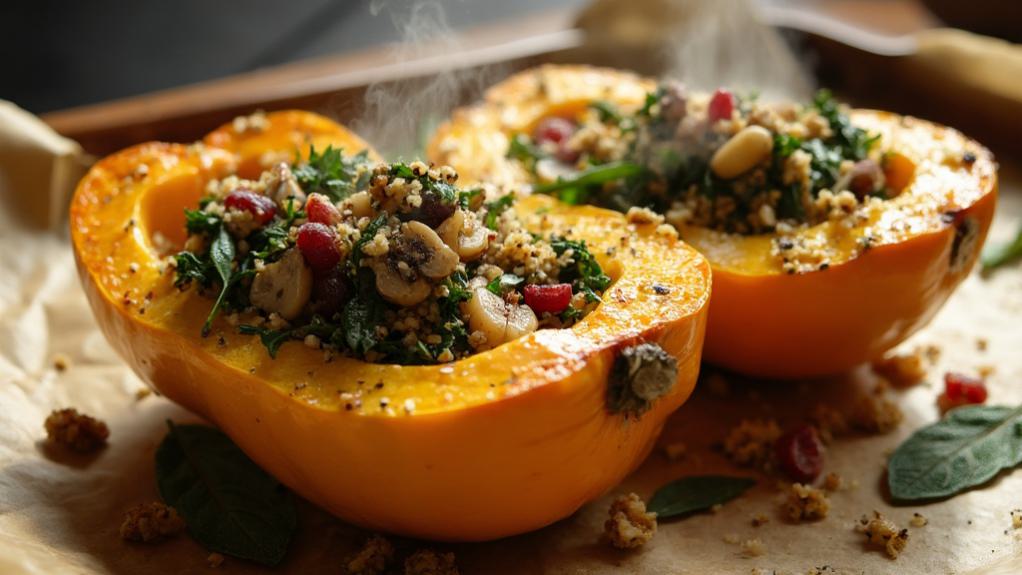Like a painter’s fresh canvas awaiting its first stroke of color, a halved butternut squash offers endless possibilities for creative expression in the kitchen. I’ve spent years perfecting my approach to this versatile vegetable, discovering that it’s not merely a vessel for filling but a crucial flavor component that transforms humble ingredients into something extraordinary.
Whether you’re seeking a show-stopping centerpiece for your next dinner party or a nourishing meal prep option, I’ll share my tried-and-true method for creating a stuffed butternut squash that balances rustic comfort with refined presentation.
Recipe
A hearty vegan main dish that transforms the humble butternut squash into an elegant and satisfying meal. The natural sweetness of the roasted squash creates the perfect vessel for a savory quinoa filling, packed with nutrients and seasonal flavors that complement each other perfectly.
The combination of protein-rich quinoa, earthy mushrooms, and vibrant kale delivers a robust and wholesome stuffing, while dried cranberries add bursts of sweetness and pecans provide a delightful crunch. This recipe celebrates autumn’s bounty while offering a complete plant-based protein source that will satisfy even the most discerning palates.
- 1 large butternut squash, halved lengthwise
- 1 cup quinoa
- 2 cups vegetable broth
- 1 onion, diced
- 2 cloves garlic, minced
- 1 cup mushrooms, chopped
- 1 cup kale, chopped
- 1/2 cup dried cranberries
- 1/2 cup pecans, chopped
- 2 tablespoons olive oil
- 1 teaspoon dried thyme
- 1 teaspoon dried sage
- Salt and pepper to taste
Preheat oven to 400°F (200°C). Remove seeds from butternut squash and brush cut sides with olive oil, season with salt and pepper. Place squash cut-side down on a baking sheet and roast for 35-40 minutes.
Meanwhile, cook quinoa in vegetable broth according to package instructions. In a large skillet, sauté onions and garlic in olive oil until translucent, add mushrooms and cook until softened. Stir in cooked quinoa, kale, cranberries, pecans, thyme, and sage.
Once squash is tender, flip halves over, fill with quinoa mixture, and return to oven for 10-15 minutes until heated through.
For optimal results, select a butternut squash that feels heavy for its size and has a uniform, beige color. The filling can be prepared up to two days in advance and stored in an airtight container in the refrigerator.
To prevent the finished dish from drying out when reheating, add a splash of vegetable broth and cover with foil. The recipe can be customized by adding roasted chickpeas for extra protein or substituting different seasonal vegetables based on availability.
Step-By-Step Cooking Instructions
You’ll start by cutting your butternut squash lengthwise and scooping out the seeds before roasting it cut-side down until tender.
While the squash cooks, you’ll prepare the filling by cooking the quinoa in vegetable broth and sautéing your vegetables with herbs and seasonings.
Once everything’s ready, you’ll combine the quinoa mixture with cranberries and pecans, fill your roasted squash halves, and return them to the oven for a final heating.
Step 1. Cut and Clean Squash

Getting started with your butternut squash requires careful preparation to ensure both safety and optimal results. You’ll need a sharp chef’s knife, a sturdy cutting board, and a metal spoon.
First, wash the squash thoroughly under cool water to remove any dirt, and dry it completely with a clean kitchen towel.
Place your butternut squash on its side and carefully cut off both ends. For easier handling, you’ll want to cut the squash into two sections: separate the narrow neck from the bulbous bottom by slicing through the middle.
Stand each section upright and slice them in half lengthwise, creating four pieces total. You’ll only need the two longest halves for this recipe, so you can save the remaining pieces for another dish.
Using a sturdy metal spoon, scrape out the seeds and stringy pulp from the cavity of each squash half. Don’t discard the seeds – you can clean and roast them later for a healthy snack.
Once cleaned, use your spoon to smooth out the cavity walls, creating an even surface for the filling.
Step 2. Roast Squash Until Tender

The perfect roasting process begins with preheating your oven to 400°F (200°C) while you prepare the squash halves for cooking.
Using a pastry brush, coat the cut surfaces of your squash generously with olive oil, making sure to cover every part of the exposed flesh. Season the oiled surfaces with salt and pepper, distributing the seasonings evenly across both halves.
Place your seasoned squash halves cut-side down on a rimmed baking sheet. This position allows the cut surfaces to caramelize and develop a rich, golden-brown color while protecting the flesh from drying out.
You’ll want to roast the squash for 35-40 minutes, or until you can easily pierce the flesh with a fork. The exact timing will depend on the size of your squash and your oven’s characteristics.
You’ll know your squash is perfectly roasted when a fork slides through the thickest part with minimal resistance. The skin should appear slightly wrinkled, and the edges of the cut surface should show caramelization.
Don’t worry if there’s some charring on the edges – this adds depth to the final dish.
Step 3. Cook Quinoa and Vegetables

While your butternut squash roasts to perfection, focus on preparing the flavorful filling that will transform this dish.
Begin by bringing your vegetable broth to a boil in a medium saucepan, then add the quinoa. Reduce the heat to low, cover, and let it simmer for 15-20 minutes until the quinoa has absorbed all the liquid and reveals its characteristic spiral.
Meanwhile, heat olive oil in a large skillet over medium heat. Add your diced onions and minced garlic, sautéing until they’re translucent and fragrant, about 5 minutes.
Add the chopped mushrooms to the pan and cook until they’ve released their moisture and begun to brown, approximately 7-8 minutes. Stir in the chopped kale and cook until it’s just wilted but still maintains its vibrant color.
Combine your perfectly cooked quinoa with the sautéed vegetables in the large skillet. Add the dried cranberries, chopped pecans, thyme, and sage, stirring gently to incorporate all ingredients.
Season with salt and pepper to taste, ensuring each component is well-distributed throughout the mixture. You’ll want the filling to be warm and fragrant when you stuff your roasted squash halves.
Step 4. Combine Filling Ingredients Together

Now that each component is ready, bring together your filling ingredients in a choreographed sequence that ensures optimal flavor distribution.
Start by transferring your cooked quinoa to a large mixing bowl, fluffing it gently with a fork to separate any clumps. Add your sautéed onions, garlic, and mushrooms while they’re still warm, allowing their flavors to meld with the quinoa.
Fold in the chopped kale next, letting the residual heat slightly wilt the leaves without fully cooking them. This maintains their nutritional value and creates a pleasant textural contrast.
Sprinkle in the dried cranberries and chopped pecans, distributing them evenly throughout the mixture. You’ll want to ensure these sweet and crunchy elements are well-dispersed for balanced bites.
Finally, add your dried thyme and sage, along with salt and pepper to taste. Give everything a thorough but gentle toss, being careful not to mash the quinoa or break up the vegetables.
If you’re making this ahead, you’ll want to let the mixture cool completely before storing it in an airtight container in the refrigerator.
Step 5. Fill and Final Bake

Once your roasted butternut squash halves have turned tender and golden, carefully remove them from the oven and flip them cut-side up on the baking sheet.
Using a spoon, gently press down on the flesh to create a deeper cavity for the filling, being careful not to pierce through the skin.
Spoon the prepared quinoa mixture generously into each squash half, mounding it slightly above the rim.
Don’t worry about packing it too tightly – you’ll want some texture and air pockets throughout.
Make sure to distribute the cranberries, pecans, and vegetables evenly between both halves.
Return the filled squash to your 400°F oven and bake for an additional 10-15 minutes, until the filling is heated through and the tops begin to crisp slightly.
You’ll know it’s ready when you can insert a knife into the thickest part of the squash and it meets no resistance.
If the top starts to brown too quickly, loosely cover with foil.
Let the stuffed squash rest for 5 minutes before serving, which allows the flavors to settle and makes it easier to portion.
Why I Love This Dish
I’ve fallen head over heels for this stuffed butternut squash because it transforms simple ingredients into an elegant masterpiece. The way the squash’s natural sweetness develops during roasting, creating a tender, caramelized vessel for the savory filling, never fails to delight my taste buds.
I’m especially drawn to how the quinoa soaks up all those wonderful flavors from the herbs and vegetables, while the dried cranberries add unexpected bursts of brightness.
What I find most appealing is this dish’s versatility and practicality. I can prep the filling in advance when I’m hosting dinner parties, and I love experimenting with different seasonal vegetables depending on what’s available at my local market.
The presentation always impresses my guests, yet it’s surprisingly simple to execute. As someone who enjoys feeding both vegan and non-vegan friends, I appreciate how this dish satisfies everyone at my table.
The combination of protein-rich quinoa, hearty vegetables, and toasted nuts creates such a satisfying meal that nobody misses the meat. Plus, any leftovers reheat beautifully for lunch the next day.

Leave a Reply